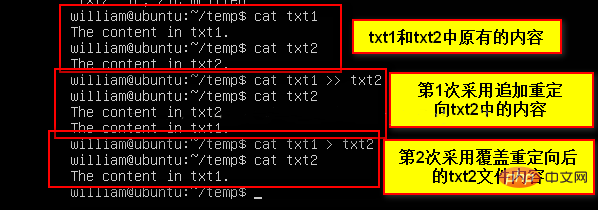 Operation and Maintenance
Operation and Maintenance
 Linux Operation and Maintenance
Linux Operation and Maintenance
 What does pipeline in Linux mean and what does redirection mean?
What does pipeline in Linux mean and what does redirection mean?
What does pipeline in Linux mean and what does redirection mean?
In Linux, a pipe is a one-way communication mechanism between two processes; the output data of one program can be input to another program through this channel. Redirection refers to modifying some of the original default things and changing the default execution method of the original system commands.

#The operating environment of this tutorial: linux7.3 system, Dell G3 computer.
Friends who are familiar with operating systems often hear and use the words pipeline and redirection. So what is a pipeline and what is redirection? Will they be useful to me? It can be said that pipelines and redirection are one of the essences of the operating system. The functions of pipelines are inseparable from all aspects of the operating system's processes, programs, and management. As for redirection, it is one of the most commonly used methods by system administrators. First, we can say without exaggeration that without pipes and redirections, it is simply impossible to manage Linux.
Pipeline:
Definition: A pipe is a mechanism for one-way communication between two processes.
Anyone who has studied operating systems knows that this one-way communication mode is called half-duplex. Because of the unidirectional nature of pipes transmitting data, pipes are also called half-duplex pipes, and this unidirectionality cannot be changed once determined.
The pipeline in Linux can input the output data of one program to another program through this channel. The pipeline in Linux is implemented through the symbol |.
Redirection:
Definition: Linux redirection refers to modifying some of the original default things and changing the default execution method of the original system command.
For example, if I don’t want to see the output on the monitor but want to output it to a certain file, I can do this through Linux redirection. Linux's redirection mechanism is implemented through the symbols , represents output.
Standard output in redirection:
An example is given in the figure below to illustrate briefly:

The creation method of txt2 in cat txt1 txt2 in the redirection command is:
1. If the file does not exist, the system will automatically create it;
2. When the file already exists, the system will first clear the file and then write the data;
3. That is to say, if you use > to output to an existing file, That file will be overwritten.
4. If you want to retain the previous content, you need to use two redirection symbols>>.
Error output in redirection:
The above introduction is based on the premise that correct results can be obtained. What if I want to find something now, but it happens to be unreachable? This requires error log. In Linux, 1 represents standard output and 2 represents error output. For example:
1>: Output the correct data to the specified file or device using the overwrite method;
1>>: Output the correct data to the specified file using the append method to the file or device;
2>: Output the incorrect data to the specified file or device by overwriting;
2>>: Output the incorrect data to the specified file or device by appending Data is output to the specified file or device.
Note: There is no space between 1 or 2 and >.
Standard input in redirection:
Before learning its standard input, let’s talk about how to get data from the keyboard.

Yes , what is the difference? We can feel it through the picture below:

Linux Video Tutorial"
The above is the detailed content of What does pipeline in Linux mean and what does redirection mean?. For more information, please follow other related articles on the PHP Chinese website!

Hot AI Tools

Undresser.AI Undress
AI-powered app for creating realistic nude photos

AI Clothes Remover
Online AI tool for removing clothes from photos.

Undress AI Tool
Undress images for free

Clothoff.io
AI clothes remover

Video Face Swap
Swap faces in any video effortlessly with our completely free AI face swap tool!

Hot Article

Hot Tools

Notepad++7.3.1
Easy-to-use and free code editor

SublimeText3 Chinese version
Chinese version, very easy to use

Zend Studio 13.0.1
Powerful PHP integrated development environment

Dreamweaver CS6
Visual web development tools

SublimeText3 Mac version
God-level code editing software (SublimeText3)

Hot Topics
 What computer configuration is required for vscode
Apr 15, 2025 pm 09:48 PM
What computer configuration is required for vscode
Apr 15, 2025 pm 09:48 PM
VS Code system requirements: Operating system: Windows 10 and above, macOS 10.12 and above, Linux distribution processor: minimum 1.6 GHz, recommended 2.0 GHz and above memory: minimum 512 MB, recommended 4 GB and above storage space: minimum 250 MB, recommended 1 GB and above other requirements: stable network connection, Xorg/Wayland (Linux)
 Linux Architecture: Unveiling the 5 Basic Components
Apr 20, 2025 am 12:04 AM
Linux Architecture: Unveiling the 5 Basic Components
Apr 20, 2025 am 12:04 AM
The five basic components of the Linux system are: 1. Kernel, 2. System library, 3. System utilities, 4. Graphical user interface, 5. Applications. The kernel manages hardware resources, the system library provides precompiled functions, system utilities are used for system management, the GUI provides visual interaction, and applications use these components to implement functions.
 vscode terminal usage tutorial
Apr 15, 2025 pm 10:09 PM
vscode terminal usage tutorial
Apr 15, 2025 pm 10:09 PM
vscode built-in terminal is a development tool that allows running commands and scripts within the editor to simplify the development process. How to use vscode terminal: Open the terminal with the shortcut key (Ctrl/Cmd). Enter a command or run the script. Use hotkeys (such as Ctrl L to clear the terminal). Change the working directory (such as the cd command). Advanced features include debug mode, automatic code snippet completion, and interactive command history.
 How to check the warehouse address of git
Apr 17, 2025 pm 01:54 PM
How to check the warehouse address of git
Apr 17, 2025 pm 01:54 PM
To view the Git repository address, perform the following steps: 1. Open the command line and navigate to the repository directory; 2. Run the "git remote -v" command; 3. View the repository name in the output and its corresponding address.
 Where to write code in vscode
Apr 15, 2025 pm 09:54 PM
Where to write code in vscode
Apr 15, 2025 pm 09:54 PM
Writing code in Visual Studio Code (VSCode) is simple and easy to use. Just install VSCode, create a project, select a language, create a file, write code, save and run it. The advantages of VSCode include cross-platform, free and open source, powerful features, rich extensions, and lightweight and fast.
 How to run java code in notepad
Apr 16, 2025 pm 07:39 PM
How to run java code in notepad
Apr 16, 2025 pm 07:39 PM
Although Notepad cannot run Java code directly, it can be achieved by using other tools: using the command line compiler (javac) to generate a bytecode file (filename.class). Use the Java interpreter (java) to interpret bytecode, execute the code, and output the result.
 What is the main purpose of Linux?
Apr 16, 2025 am 12:19 AM
What is the main purpose of Linux?
Apr 16, 2025 am 12:19 AM
The main uses of Linux include: 1. Server operating system, 2. Embedded system, 3. Desktop operating system, 4. Development and testing environment. Linux excels in these areas, providing stability, security and efficient development tools.
 How to run sublime after writing the code
Apr 16, 2025 am 08:51 AM
How to run sublime after writing the code
Apr 16, 2025 am 08:51 AM
There are six ways to run code in Sublime: through hotkeys, menus, build systems, command lines, set default build systems, and custom build commands, and run individual files/projects by right-clicking on projects/files. The build system availability depends on the installation of Sublime Text.





